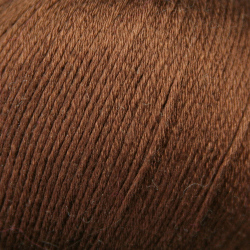
Jaeger Yarns Silk 4-ply © YarnSub
Characteristics
- High luster
- Inelastic
- Warm (warmer than wool)
- Strong
- Good absorbency
- Susceptible to moths
- Snags and pills over time
- Usually hand wash only
What's in your yarn?
100% silk yarns are not all the same. Different types of silk are produced depending on the species of silkworm that made it, what they ate as caterpillars, whether the adult silkmoth was allowed to exit the cocoon, and the methods used to prepare the silk for use.
Mulberry silk is produced by Bombyx mori, fed exclusively on mulberry leaves, and is usually considered the finest silk, with the longest fibers and the most shine.
Tussah silk is primarily produced by larvae of Antharaea species, which eat oak or fruit tree leaves. Tussah silk fibers tend to be shorter, but stronger.
Silk noil is all the lumpy bumpy bits left over after the long silk fibers have been taken away. They can be included in yarn for a tweedy texture.
Silk from about 150 silkworms is needed to make one 50g skein of silk yarn.
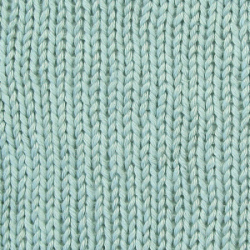
100% silk stockinette stitch, after blocking
Knitting with silk
- Try and keep an even tension as the lack of elasticity means silk is not forgiving on the look of your finished fabric if your tension varies as you knit. There will be some improvement after blocking though.
- The stitches are slippy and if they come off your needles they can be difficult to catch before dropping down to the rows beneath. Use wood or the coated-metal needles if you have problems, rather than the old-fashioned metal needles. Consider using a life-line for lace knitting.
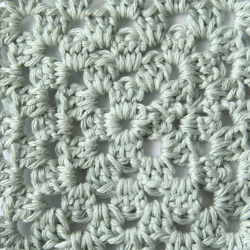
100% silk crocheted granny square
Crocheting with silk
Silk can be great for crochet, but be careful to choose a stitch pattern that shows off the drape. This granny square swatch was made using a 3.5mm hook and 4-ply/fingering weight yarn, and it gave a dense fabric that had lost much of its drape. Experiment with hook size and a more open stitch pattern.
Designing with silk
Designs that work
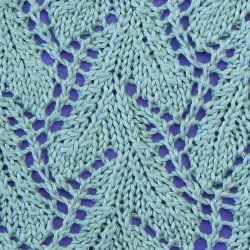
Lace pattern in 100% silk
- Lacey scarves and shawls - lace patterns are more forgiving of an uneven tension while knitting and the relaxation of the stitches only serves to accentuate the lace holes in the stitch pattern.
- Gracefully draping tops - use the drape of the fabric to best advantage by making slinky tops that skim over the body.
Designs that don't work
- Long and heavy garments - the lack of elasticity and smooth fibers mean that silk garments will stretch with gravity. Don't make your garment too long, and consider the weight that design elements like cables would add to the fabric.
- Figure-hugging designs - with the lack of elasticity, the stitches relax with wear and fitted sections will droop. The same goes for ribbing, there's no elasticity to draw the fabric in.
Be wary with...
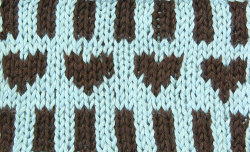
Fair-isle in 100% silk
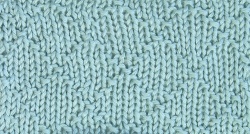
Knit and purl texture pattern
Colorwork - while it's possible to use silk for designs using fair-isle or intarsia techniques, colorwork techniques tend to work best with a yarn like wool, which has elasticity and plumpness to hide gaps and tension inconsistencies. This fair-isle swatch is one of the few swatches that looked worse after blocking. The stitches relaxed away from each other, revealing the stranding at the back of the fabric.
Knit and Purl textured stitch patterns - the bumps of the purl stitches sink back into the main body of the fabric as there is no springy resilience to keep them in place. Rib patterns will not pull in the fabric at all after blocking or once stretched. However, silk's light reflecting properties can be exploited with an all-over knit/purl stitch to give a subtle effect from the light and shade produced by the changing texture. The swatch shows how this diamond pattern, over a larger area of silk fabric and using a light-colored yarn, would give an attractive effect - perhaps in the lower section of a jumper or cardigan.
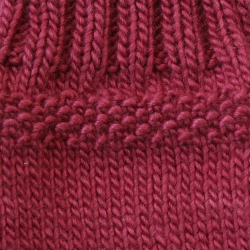
Louisa Harding Grace - 50% silk, 50% wool
Blends of silk and other fibers
The luster and luxurious feel of silk can be combined with other fibers to introduce elasticity and bounce. The swatch of Louisa Harding's blend of wool and silk in Grace shows how the elasticity of wool and the reflective sheen of silk combine to show off the texture in knit and purl patterns. The trade-off is that some of the drape is lost. There are many 50% wool, 50% silk yarns available, Alpaca/Silk blends are soft and lustrous, or silk can be used to add sheen and warmth to blends with plant fibers.
